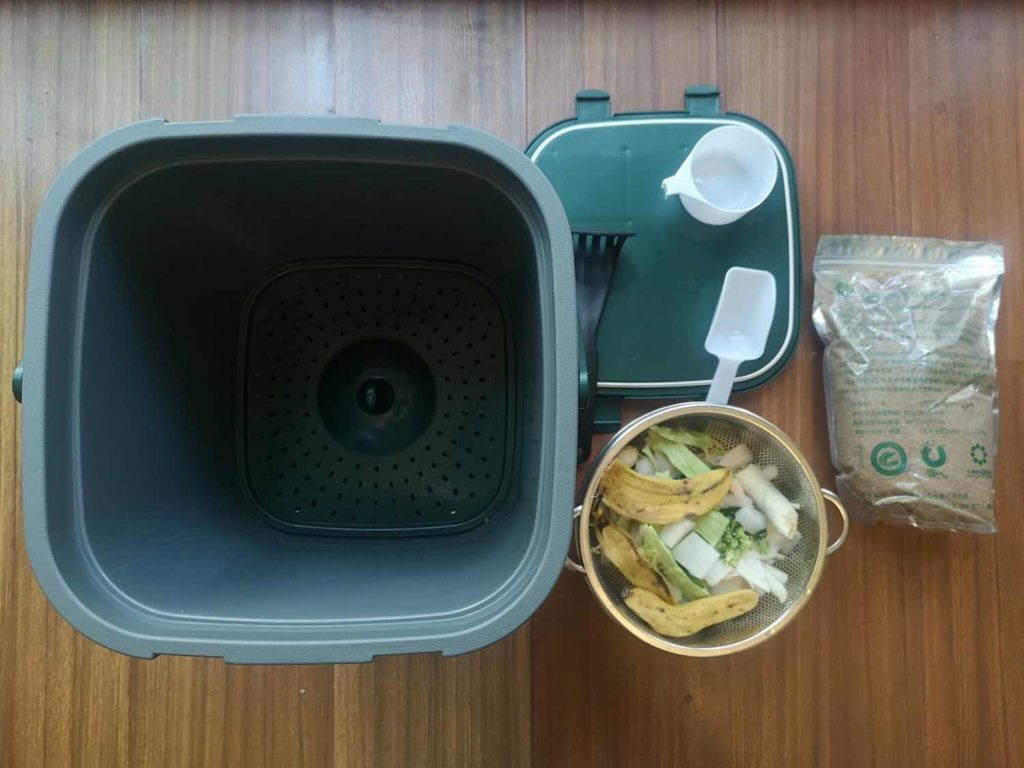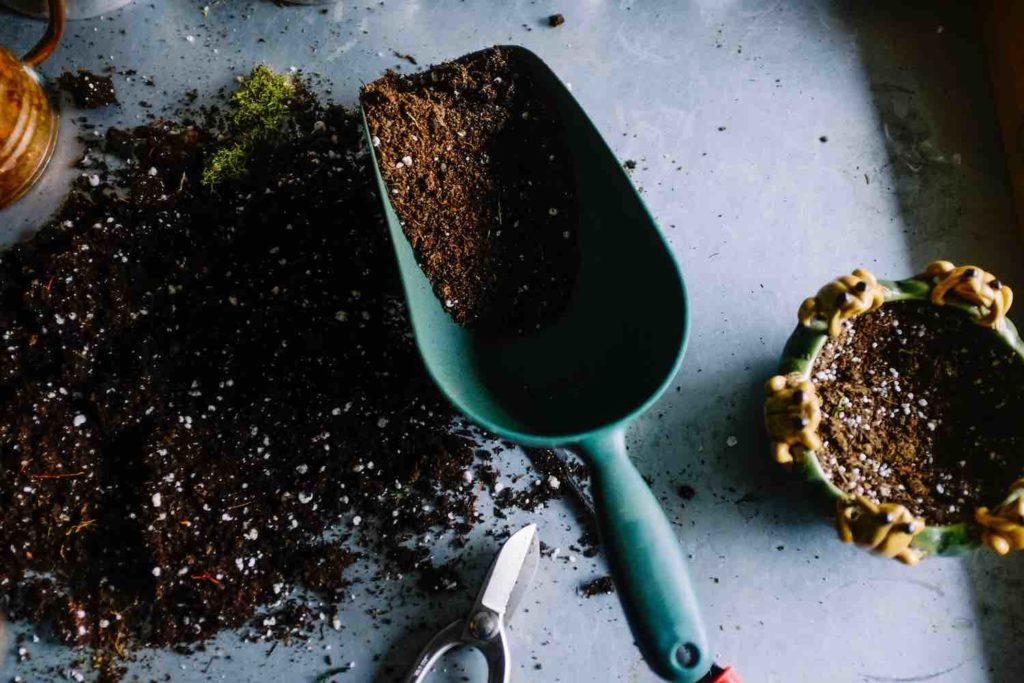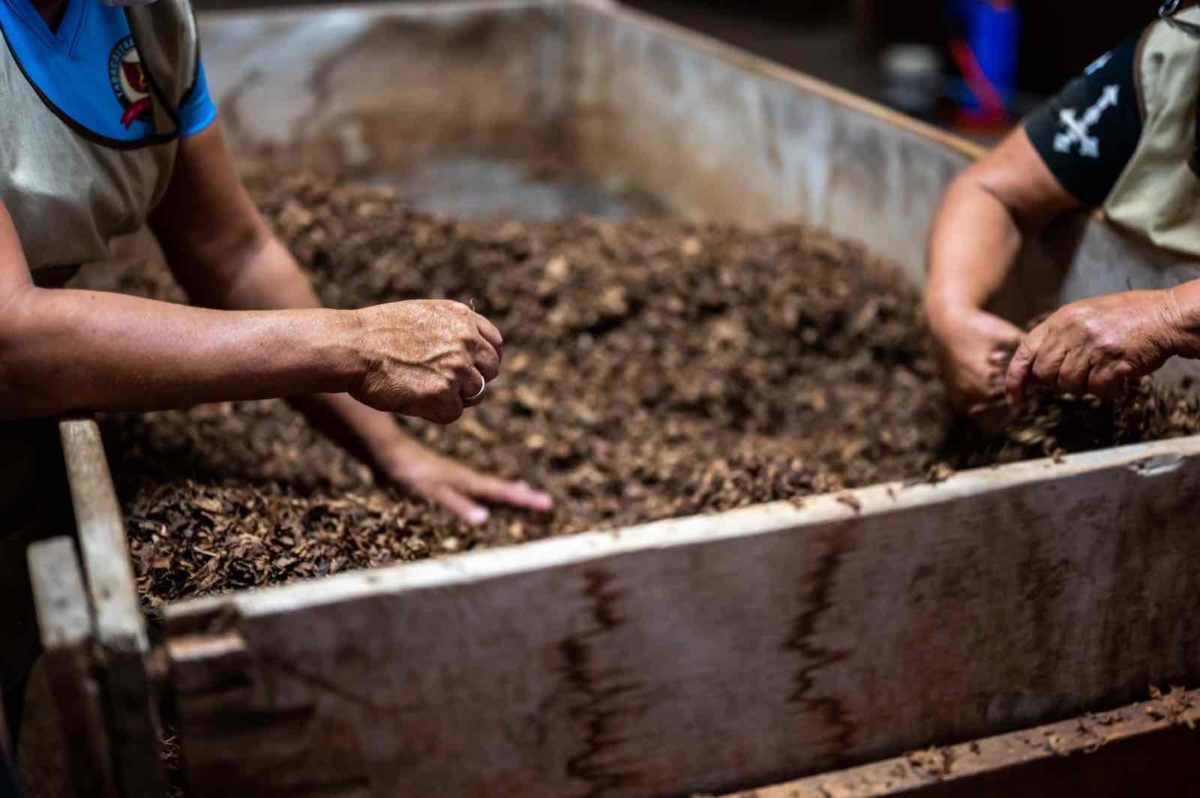If you’re looking for an easy way to start composting, or have a lack of space for a traditional compost, the Bokashi method may be the right choice for you.
This guide will show you how to get started with Bokashi composting, including what materials you’ll need and how to set up your system.
What is Bokashi?
Bokashi composting is a very simple composting method that allows you to add kitchen waste, directly into the composter without creating unpleasant odors. Unlike traditional composting, which takes several months to years, Bokashi can process your organic food waste in just 4 weeks!
If you’re ready to get started, keep reading for a step-by-step guide to setting up a Bokashi system including what you need to get started.
The Bokashi system: A method using fermentation
The Bokashi fermentation process, where you let food scraps ferment for 1-2 weeks in a mixture of Bokashi bran and water, is the most common Bokashi composting technique.
This fermentation process is very simple and doesn’t require any special equipment (unlike traditional composting methods, which require a composter).
Once the scraps have gone through the fermentation stage, you can bury them in your garden or add them to your compost pile. The fermented scraps make valuable organic fertilizer for use in the garden.
The Bokashi process involves three simple steps:
- Mixing the bran with water
Mix your Bokashi bran with water and add it to your food scrap container.
- Add food and kitchen scraps
Add the food scraps as usual and cover them with more of the dry bran, and let sit.
- Wait for 2-4 weeks
The mixture will ferment into rich fermented material which is an excellent organic fertilizer that you can use in your garden or as potting soil!
The microbes that ferment the food waste (anaerobic bacteria) are very sensitive to oxygen. The small amount of air that permeates into the container during fermentation will keep these beneficial organisms alive and working in your composter.
The air that enters the container is taken in by tiny pores in the walls of the bin (which can be made from any food safe material, such as wood or plastic), and diffused into the scraps when they are piled up.
This small amount of air allows aerobic microbes to grow alongside anaerobic microbes, producing a fermentation process that requires no additional oxygen.
The air exchange in the composter will only enhance the aerobic microbes in your compost pile/container, which can make your scraps decompose more quickly and easily than they would otherwise.
Adding “young” (fresh) Bokashi bran to your scraps enhances this process by providing an additional source of aerobic microbes that can jump into action when food scraps are added.
The Bokashi tea
The acidic liquid that settles at the bottom of your composter is quite often referred to as “the Bokashi tea”, which allegedly is a very nutritious fertilizer for plants. While many people swear by this liquid, it doesn’t have a particularly pleasant smell and will need to be diluted before being added to your plants. Many gardeners dilute one part tea to 10 parts water so they don’t kill the plants!
Where did Bokashi come from?
Bokashi is a Japanese word that means “fermented organic matter.” The fermentation technique was developed as a way to help reduce the amount of organic waste Japan sent to landfill.
In 1999, a law was passed in Japan requiring all food businesses and government facilities to separate out their organic kitchen waste for composting. This new requirement resulted in a lot of food waste with nowhere to go. A system was devised in 2001 to make use of this excess organic matter, which is now known as Bokashi composting.
Bokashi composting has since evolved into a worldwide movement that allows people with limited space or no access to open fields to compost their food scraps with Bokashi bran.
It has been embraced by both commercial and household composters looking for an efficient, environmentally-friendly alternative to the traditional method of food waste disposal.

What you will need to get started with the Bokashi method
Bokashi is an inexpensive composting method that requires very few tools or materials. This is why Bokashi has become so popular amongst people living in smaller spaces, like tiny houses or apartments. Here’s what you’ll need:
- A container for the scraps: You can use a lidded garbage can, a wooden bin with holes drilled in it, or even an old plastic trash can with a tight fitting lid. Just make sure the container is food-safe and has good air flow (lidded containers will need small holes drilled in them). There are obviously more exclusive alternatives such as what’s known as a “Bokashi bin” or “Bokashi bucket”.
- Bokashi Bran: This special bran is inoculated with beneficial microbes that help ferment the scraps, eliminate odors, and suppress weed growth in your garden. You can purchase pre-made Bokashi bran, or make your own.
- Follow instructions on how to prepare the bran will be included with your purchase. You will need 1/4 cup (60 ml) of prepared bran per day for a family of four. A 4 lb (1.8 kg) bag is enough to last most households about 2 months.
- Kitchen Scrap Container: You can use any food-safe container for storing your scraps, as long as it has good airflow and is large enough for the scraps to lay flat at the bottom. You can purchase one specially designed for keeping food waste or you can save leftovers in the original containers from takeout or food deliveries.
- Lid: Make sure your container has a tight fitting lid, or drill ventilation holes in the lid of an open container. The Bokashi bran will ferment, producing some gas that needs to escape the container. A tightly sealed lid will keep excess moisture in and odors out (and keep wandering pets out too!).
Benefits of Bokashi Composting
Bokashi composting is a simple and efficient way to compost food scraps using anaerobic bacteria.
The composting process of fermenting food scraps in a bin with Bokashi bran produces valuable organic fertilizer for use in the garden soil, while also reducing the amount of waste sent to landfill.
Bokashi composting is perfect for people with limited space or no access to open fields.
Bokashi: The Pros and Cons
Pros
- Easy to start!
- You can use a Bokashi bin in your home or office to compost food scraps
- It’s great for people with limited space outside to make their own compost pile
- It’s an eco-friendly, affordable and sustainable way of producing fertilizer for your garden
Cons
- Requires a more hands on approach to composting
Is Bokashi better than composting
Bokashi offers many benefits, but regular composting in the open is great because it gives you the freedom to compost wherever you have space.
If having your own pile of smelly compost isn’t feasible for some reason, definitely consider Bokashi! It will reduce the amount of waste you send to landfill and reduce smells as long as it gets emptied regularly.
Why choose Bokashi composting?
If done correctly, Bokashi composting can be odorless and it won’t attract pests like skunks or raccoons. However, if you don’t keep up with your scraps regularly (like when on vacation) they will quickly pile up and start to smell. If you travel often for work, it’s best to consider a self-contained Bokashi system such as the Envirocycle Composter.
Bokashi is an efficient way of composting your food scraps and producing valuable organic fertilizer – just make sure that if you choose this method that you get started right away!

Creating your own Bokashi system
You’ll need the Bokashi bran/EM, you can purchase these items at your local garden center. Look for the words “Bokashi” or “Fermented Bran Meal” down the aisles.
Step 1 – Drill drainage holes in the bottom of the bucket
Step 2 – Add molasses to the bottom of your container
Bokashi Bran or EM is pretty expensive, so you can use regular wheat bran instead. First mix in half a cup of molasses (this will feed the anaerobic bacteria) and then add one or two cups of bran (about a handful). Mix everything together.
Step 3 – Add food scraps, cover with an airtight lid and let ferment for at least two days before emptying
It’s time to start composting! Add all of your food scraps (meat should be pre-composted separately first), mix it up with the bran/EM, and then cover it with an airtight lid.
You’ll probably start to smell the fermentation process within a day or two – this is normal! Some people like to add water, but this may result in mold growth so only do so if you are using EM instead of bran.
Step 4 – Empty your bucket every 1-2 weeks, depending on the volume
Once your bucket is full of compost, it’s time to empty it. Some people do this by putting a smaller container inside their bin and emptying out the scraps into that. If you have a garden or plants nearby, just pour the contents directly onto them for direct crop fertilization. You can also add it to your compost pile in the open if you want!
Step 5 – Stir in more bran with molasses
After filling up your bucket, make sure to stir in some more bran with molassess. You can do this every time you empty the bin, or just when necessary (when it starts to smell bad). When adding new scraps, try not to add too much at once or you risk anaerobic decomposition. If possible, work in batches to empty the bucket so that there is always some compost inside it compared to if you just dumped everything in there together.
Troubleshooting tips for Bokashi composting
A Bokashi compost can be a great way to start organic home composting or even in the office, but it’s important to keep an eye on things. Here are some common problems that may occur when Bokashi composting and their remedies:
Problem – There is black slime on the surface of the bran
- Possible cause – Too much water or letting the scraps sit at room temperature for too long
- Solution – This is anaerobic decomposition (a no-no) and not what you want. Add more bran ASAP, stir it in well, and cover everything again. If the odor gets bad, double up on the bran and consider transferring your scraps to another container.
Problem – The lid is bulging
- Possible cause – Air is getting in which anaerobic bacteria don’t like
- Solution – Covering the bucket with a cloth can help, or if you have spare buckets lying around, transfer your scraps to them and let ferment for another week or so before opening again. Otherwise, just open it up carefully and don’t worry about it!
Problem – There is a lot of white mold
- Possible cause – Too much molasses, not enough water, or leaving scraps at room temperature for too long.
- Solution – Rinse out the bucket with some warm water to remove as much as you can, making sure you have stirred in your bran and molasses mixture. If the smell stays bad, double up on the bran and let it ferment again for another week or so before checking again.
Problem – There is no mold growth
- Possible cause – Not enough moisture in the bucket or scraps were too dry.
- Solution – You can mix in some water if you want to speed up the process or try adding more scraps. Bokashi composting is almost guaranteed, but it may take a bit longer without the moisture.
Problem – There are no signs of fermentation (no smell, mold growth)
- Possible cause – Not enough bran or molasses, not enough oxygen getting in, or the scraps were too wet.
- Solution – If you double up on your bran/molasses mixture and make sure to cover all of the scraps with it as much as possible, this should fix things. If not, try getting some more oxygen into the bucket by keeping the lid slightly ajar for a day or two.
Bokashi Composting vs. Traditional Composting
Bokashi composting and traditional composting are two different ways of breaking down organic matter in a decomposition process to another material. While both have their benefits, bokashi composting is a bit more forgiving and can be done in smaller spaces. Let’s take a closer look at the differences between the two methods!
A regular compost is a little more rigorous and requires a lot of space, both outside and inside your home. It also requires a fair amount of work to turn the compost every day or two to aerate it and make sure that organic matter is getting broken down at a sufficient rate.
Traditional compost piles are usually made using an outdoor compost bin or tumbler which can make the whole process even more involved. While this kind of composting is great if you have access to space and especially if you are aiming for large scale production, it’s not practical in many cases.
Bokashi on the other hand, can be done in almost any sized container with little work or extra equipment. Even though it requires a bran mixture and some molasses, you can keep these ingredients in your kitchen for months before needing to get more.
If you need to speed up the process or just don’t want to worry about all of that fermenting, then go ahead and add some extra water instead of molasses. Keep in mind that if you do this, you might need to wait longer for the fermentation process to complete.
Bokashi bins are usually made of wood or plastic and can be found at any home improvement store. They may cost a little bit more than your regular compost bin, but they are much easier to use and require much less maintenance. If you have kids, pets, or even just don’t feel like getting dirty with your composting, bokashi may be the method for you.
Another thing to keep in mind is that it’s not too hard to make a mini-bokashi bin at home if you want to save some money. As long as you have space and can find an old ice cream bucket without any dents, you are good to go.
Traditional Composting vs Bokashi Composting Conclusion
Both compost methods have their pros and cons, but bokashi is a bit more forgiving for first timers or those who don’t want the hassle of dealing with big piles, or deal with yard waste.
It’s easier on your wallet, on the space it takes, and on your time as well. As long as you know what to look out for and can keep an eye on things, bokashi composting is a great, much more eco-friendly alternative to traditional composting.
We hope you enjoyed this post and that you’re ready to start composting!
FAQs about Bokashi composting
Bokashi composting is a great alternative to traditional composting. It’s easier on your time, space, and wallet while still producing the same quality of compost.
The easiest way to start bokashi is to pick up a pre-made kit. It’s likely that you can find one at stores around you.
Bokashi is a fermentation process that uses bran and molasses to quickly turn your organic matter into good compost.
Composting takes a long time and needs a lot of work to turn the pile, bokashi is a faster fermentation process. It also outputs a great fertilisation.
Yes. Bokashi speeds up the process of composting by fermenting e.g. kitchen scraps.
Bokashi takes about 2 weeks to decompose in an airtight bucket.
The end product of bokashi does not smell.
Bokashi is a mixture of bran, molasses and water.
Almost anything can be used for bokashi. It is best to avoid meat, fish and dairy.
In general, try to avoid putting in materials that are not organic as this can contaminate your bokashi.
No, bokashi should always be used in a dedicated composting container.
Yes, bokashi can be added to a worm bin.
Yes. Leaves are an excellent addition.

4 replies on “Bokashi Composting Guide: How to start Bokashi Composting”
[…] on the other hand, are attracted to damp places like soil or decomposing leaves. They sometimes enter homes through open windows or […]
[…] vegetables is normally a great way to start. The easiest way would be using organic materials like dead leaves or compost in order to make it suitable for growing […]
[…] the weather starts to cool down, a cultivator can be used to till in the fall crops so they can decompose over the winter and add organic matter back into the […]
Thanks a lot about the bokashi information